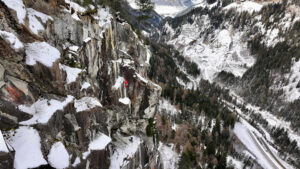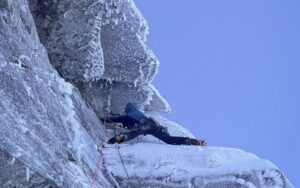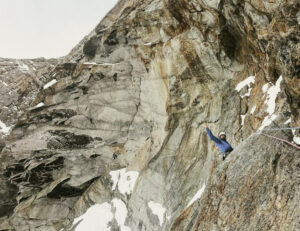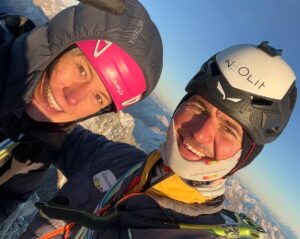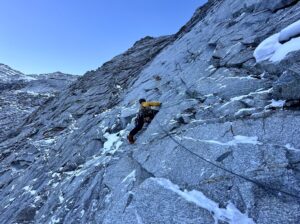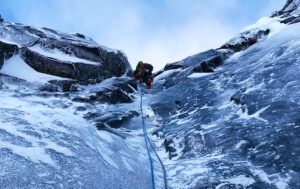While ice climbers in some places need to look hard for the right conditions and rush to do routes before they melt, there is a place where the frozen waterfalls remain nearly unchanged for months.
After checking the state of the ice in Scotland with Tim Miller and in Nepal with Vinayak Malla, Piolet d’Or winner Ian Welsted takes us to one of the world’s climbing meccas. Welsted, who guides ice climbing all winter, shares insider tips for the Canadian Rockies and specifically, the Icefields Parkway.
A long-time Canmore resident, Welsted now lives just across the provincial border in Golden, B.C. Golden is a great ice and mixed climbing spot, especially during stormy spells such as this week.
Cold. Colder
Canada is known as the best place on Earth for long routes of vertical ice climbing. Perhaps only Norway is a close competitor. The main reason, besides the mind-blowing landscapes, is that — obvious as it may be — it’s cold in the Canadian Rockies.
It’s colder, Welsted says, than the U.S. mountains. For ice climbers, as long as they can bear it, that has a wonderful consequence. The ice remains stable for weeks during a long season that spans from October to April.
“That’s probably what sets Canada apart,” says Welsted. “Ice may well form in October, and there’s going to be ice to climb until typically the second week of April.”

Carlsberg Column (WI5, 140m). Photo: Peter Hoang
“People tend to come in January and February because during these months, ice is 100% guaranteed. There’s never a year without ice in these months,” Welsted explained. “But I have to say that these are my least favorite months because it is so cold and the days are so short.”
Grand scale and wild environment
Equally obvious, there’s a lot of ice climbing in the Canadian Rockies. “Not surprising for an area the size of Switzerland and Austria combined,” Welsted said. “It also means that you may need to drive four or five hours from one climbing spot to the next. Therefore it is wise to plan ahead and decide where one is going to climb.”
“Those intending to come must rent a car unless you have friends to drive you around, because there is no public transit [to ice climbing areas] in Canada. Forget about places like Chamonix where you can get everywhere with buses, trains, and lifts.”
Hot ice spots
“Most ice climbers heading for the Canadian Rockies fly into Calgary, east of the mountains. They stay in Banff or Canmore, both lively towns, with plenty of ice of all lengths and grades of difficulty. Ice is easily accessible by car and then approach on foot, from 10 minutes to over an hour. Banff is by the Bow River, a highly scenic setting with routes on the walls of river canyons as well as high on cliffs overlooking the valley.”
“The problem is, the closer to the towns, the more crowded the ice climbing routes,” Welsted points out. His suggestion? “Go west.”

Map of the roads and best ice climbing areas. Photo: Eric & Lucie Bus Trips
An hour’s drive north of Canmore is Lake Louise or, even better, follow Welsted’s tip and head for the Rampart Creek Hostel. This isolated place is perfect for ice climbers, basic but right in the middle of the action.
“That is the only hostel that remains open all winter long. It is along the Icefields Parkway, a mountain road that runs north from Lake Louise to Jasper,” Welsted says.

Jesse Milner on the first pitch of Curtain Call. Photo: Ian Welsted
“It is a highway but not a main one, no big trucks are crossing it. It is usually well maintained through the winter, although it may close in case of big storms.”
The Icefields Parkway has a reputation as one of the most beautiful wild roads in the world. Expect no accommodation, restaurants, or gas stations in hours of driving. In exchange, there are glaciers, deep valleys, sharp peaks, and some of the most famous ice-climbing spots in Canada. It is here you can find the likes of the Weeping Wall or the coveted Polar Circus.
“Some of my clients, used to attainable routes just outside towns like Ouray [in Colorado], are surprised by what they call a ‘truly alpine’ climbing experience with a longer approach in pure wilderness,” Welsted said.

Climbing Mixed Master, with the Icefields Parkway below. Photo: Ian Welsted
“The Weeping Wall is just 10 minutes walk from the road and comprises at least 30 multi-pitch ice routes; in the same area are the mythical Curtain Call or Ice Nine,” Westeld said. “You can spend a week in the hostel and visit different routes each day.”
Away from the crowds
Those wanting to stay away from crowds may prefer to head for Jasper.
“It can be accessed by flying to Edmonton and driving for four hours. But the road is not as scenic as the one from Banff. Perhaps it is not the most rewarding first impression, especially for those who are experiencing their first Canadian winter.”
On the west side of the Rockies, already in British Columbia, suitable base locations include Field, inside Yoho National Park. This is near well-known climbs like Guinness Gully, Pilsener Pillar, Carlsberg or Superbock, and the town of Golden.

Sergey Tsibel on Superbock. Photo: Ian Westeld
Not for beginners
Although there are a few crags where you can go top-roping, like some just out of Canmore, that’s not what the area is known for among winter climbers.
The Icefields Parkway is famous for hard mixed-climbing. It features dry tooling up to M7, leading to overhanging ice sections that attract some of the most gifted climbers around, such as Jeff Mercier and Greg Boswell.
“These conditions in Europe don’t last for long, but here, when the ice sets in, the route remains in good condition for many weeks.”

Ian Welsted on the first pitch of Exterminator. Photo: Ian Welsted
Though there are many hard-as-nails routes, there are options for a range of difficulties. “On the Weeping Wall, for instance, some routes start with WI5 pitches and then the difficulty increases to WI6, so you can get as far as you want and climb as hard as you want,” Welsted said.
Avalanche hazard
Ice climbing in the Rockies means climbing in the wilderness in severe winter conditions. Avalanches are a serious hazard. Many routes are exposed and there have been sad episodes in famous spots, like Polar Circus. “It is mandatory to check the weather and snow forecast in advance,” Welsted warns. You can find weather details at Avalanche.ca.
The climbing community still keeps fresh memories of David Lama, Hansjorg Auer, and Jess Roskelley. The trio perished in an avalanche while climbing Howse Peak, located just off the Icefields Parkway.
“The avalanche hazard is especially high during January and February,” Westeld said. “Nick Bullock and Greg Boswell visit the Canadian Rockies almost every year and they usually come at the beginning of November, when avalanche risk is lower. However, this early start means longer approaches and the ice starts higher up.”

Avalanche down the waterfall on Polar Circus. Photo: Max Darrah
When avalanche conditions are hazardous, a favorite spot for local climbers is Ghost Valley, east of the Rockies near Calgary. It has lots of ice, and little avalanche risk.
However, reaching the ice involves off-road driving in winter conditions, which can be a challenge. For some, just getting to the ice is part of the adventure, but Welsted isn’t convinced. “If I go ice-climbing, I want to spend the day ice-climbing, not focusing on another adventure such as off-road driving.”
Style and ethics
Unlike other ice-climbing areas around the world, bolts are quite common at mixed climbing routes.
“Bolting is very prominent and for a good reason,” Welsted explains. “The rock here is notoriously bad, it is limestone but very broken, possibly because of the fluctuating temperatures.” Because of this bad rock, locals sometimes call the Rockies “the Rottenies.”

JP Oullette on Exterminatior. Photo: Ian Welsted
There are no access restrictions for the ice climbing routes, but visitors need a national parks pass and should respect the park rules. Otherwise, the environment is pretty relaxed. However, this may change as more people gather on the most popular routes. Crowding is starting to become an issue.
“Ice climbing is becoming more popular in Canada and we are getting more visitors,” Welsted said. “For Americans in particular, the season is getting shorter and shorter, and they come here.”
There is also an increasing number of European climbers. “They are used to crowded places and also to some tactics that are not so familiar to locals. They will sometimes climb below another team on the same route and in some cases blaze past slower teams.”
As Welsted explained, places that seem crowded for Canadians are just fine for European climbers used to the masses in places like Chamonix.
“There are routes where it is fairly safe to start below another team because the ice surface is big,” he says. “Yet it is still uncommon here. With an increasing number of climbing pairs, it is becoming a big issue.”
Information hard to find
Another issue is the relative lack of information. There is no guidebook for ice climbing in the Canadian Rockies, Welsted said. The one everybody used is out of print.
“Will Gadd bought the rights to the guidebook and used it to build an App, but it does not work on my Android phone. As far as I am aware, it’s only for Apple phones. As usual, there is info on the internet and some active Facebook groups, but as with everything on the net, the information should be taken with care. Of course, Canadians are quite friendly and willing to give advice and information if you ask local climbers.”

Photo: Ian Welsted
A whole world of ice ahead
During our chat, Welsted reflected on ice climbing as a part of mountaineering activities or as a passion on its own.
I started climbing because I wanted to climb mountains and then eventually I got into ice climbing. I learned the techniques in Chamonix and then moved to Canmore, where ice climbing is the main thing in the winter, as well as dry tooling. I started doing it because I wanted to acquire the skills to climb Denali and other peaks. However, in winter, going ice-climbing is much easier than trying to climb mountains in such cold conditions. There’s so much steep ice, it’s what you see most when you look around. Back then, I would climb a hundred days of ice a season.

Ian Welsted at the Weeping Wall. Photo: Ian Welsted



